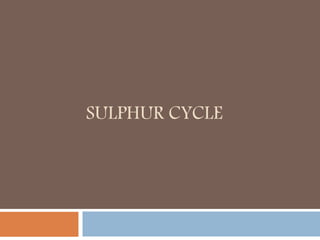
Sulphur cycle
- 2. Sulphur cycle Microorganisms contribute greatly to the sulfur cycle. Photosynthetic microorganisms transform sulfur by using sulfide as an electron source, allowing Thiobacillus and similar chemolithoautotrophic genera. In contrast, when sulfate diffuses into reduced habitats, it provides an opportunity for different groups of microorganisms to carry out sulfate reduction. For example, when a usable organic reductant is present, Desulfovibrio uses sulfate as an oxidant. This use of sulfate as an external electron acceptor to form sulfide, which accumulates in the environment, is an example of a dissimilatory reduction process and anaerobic respiration.
- 3. In comparison, the reduction of sulfate for use in amino acid and protein biosynthesis. Other microorganisms have been found to carry out dissimilatory elemental sulfur reduction. These include Desulfuromonas, thermophilic archaea and also cyanobacteria in hypersaline sediments. Sulfite is another critical intermediate that can be reduced to sulfide by a wide variety of microorganisms, including Alteromonas and Clostridium, as well as Desulfovibrio and Desulfotomaculum.
- 4. In addition to the very important photolithotrophic sulfur oxidizers such as Chromatium and Chlorobium, which function under strict anaerobic conditions in deep water columns, a large and varied group of bacteria carry out aerobic anoxygenic photosynthesis. These aerobic anoxygenic phototrophs use bacteriochlorophyll a and carotenoid pigments and are found in marine and freshwater environments; they are often components of microbial mat communities. Important genera include Erythromonas, Roseococcus, Porphyrobacter, and Roseobacter.
- 5. “Minor” compounds in the sulfur cycle play major roles in biology. An excellent example is dimethylsulfoniopropionate (DMSP), which is used by bacterioplankton (floating bacteria) as a sulfur source for protein synthesis, and which is transformed to dimethylsulfide (DMS), a volatile sulfur form that can affect atmospheric processes. When pH and oxidation-reduction conditions are favorable, several key transformations in the sulfur cycle also occur as the result of chemical reactions in the absence of microorganisms. An important example of such an abiotic process is the oxidation of sulfide to elemental sulfur. This takes place rapidly at a neutral pH, with a half-life of approximately 10 minutes for sulfide at room temperature.
- 7. Iron Cycle The iron cycle includes several different genera that carry out iron oxidations, transforming ferrous ion (Fe2) to ferric ion (Fe3). Thiobacillus ferrooxidans carries out this process under acidic conditions, Gallionella is active under neutral pH conditions, and Sulfolobus functions under acidic, thermophilic conditions. Much of the earlier literature suggested that additional genera could oxidize iron, including Sphaerotilus and Leptothrix. These two genera are still termed “iron bacteria” by many non microbiologists. Confusion about the role of these genera resulted from the occurrence of the chemical oxidation of ferrous ion to ferric ion (forming insoluble iron precipitates) at neutral pH values, where microorganisms also grow on organic substrates. These microorganisms are now classified as chemoheterotrophs.
- 8. Recently microbes have been found that oxidize Fe2 using nitrate as an electron acceptor. This process occurs in aquatic sediments with depressed levels of oxygen and may be another route by which large zones of oxidized iron have accumulated in environments with lower oxygen levels. Iron reduction occurs under anaerobic conditions resulting in the accumulation of ferrous ion. Although many microorganisms can reduce small amounts of iron during their metabolism, most iron reduction is carried out by specialized iron-respiring microorganisms such as Geobacter metallireducens, Geobacter sulfurreducens, Ferribacterium limneticum, and Shewanella putrefaciens, which can obtain energy for growth on organic matter using ferric iron as an oxidant.
- 9. In addition to these relatively simple reductions to ferrous ion, some magnetotactic bacteria such as Aquaspirillum magnetotacticum valence iron oxide mineral magnetite (Fe3O4) and construct intracellular magnetic compasses. Furthermore, dissimilatory iron reducing bacteria accumulate magnetite as an extracellular product. Magnetite has been detected in sediments, where it is present in particles similar to those found in bacteria, indicating a longer term contribution of bacteria to iron cycling processes.
- 10. Genes for magnetite synthesis have been cloned into other organisms, creating new magnetically sensitive microorganisms. Magnetotactic bacteria are now described as magneto-aerotactic bacteria, due to their using magnetic fields to migrate to the position in a bog or swamp where the oxygen level is best suited for their functioning. In the last decade new microorganisms have been discovered that use ferrous ion as an electron donor in anoxygenic photosynthesis. Thus, with production of ferric ion in lighted anaerobic zones by iron-oxidizing bacteria, the stage is set for subsequent chemotrophic-based iron reduction, such as by Geobacter and Shewanella, creating a strictly anaerobic oxidation/reduction cycle for iron.